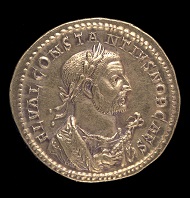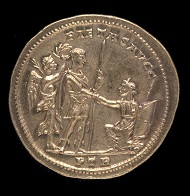August 25, 2016 – The Spotlight exhibition ‘Constantius: York’s Forgotten Emperor’ reveals the story of Constantius Chlorus (250-306 AD) who made his name in Britain, defeating rebellious generals and fighting Picts north of Hadrian’s Wall. While campaigning in Britain he was based in York (Eboracum), where he died and his son Constantine succeeded him.
The Spotlight exhibition features several of the most impressive coins from the British Museum’s Beaurains Hoard, found in France in 1922. It dates from AD 315 and graffiti on one medallion suggests it belonged to Vitalianus, who was an experienced junior officer in the Roman army.
Part of the Beaurains Hoard. Medallion of 5 aurei of Constantius I. Reverse depicting Constantius raising Britannia from her knees. Photo: The Trustees of the British Museum.
The hoard contains several coins which commemorate Constantius’ success as conqueror of Britain. One example shows the emperor lifting a kneeling Britannia to her feet. Another celebrates the victory of the army at London, with the emperor on horseback marching into the town which is marked ‘LON’.
The medallion has the legend REDDITOR LVCIS AETERNA, meaning ‘Restorer of eternal light’. The coins and medallions were issued across the empire, helping to spread the word of Constantius’ victory.
The exhibition also features the Wold Newton Hoard and the marble head of Constantine, Constantius’ son who was declared Emperor in York following the death of his father.
Who was Constantius?
Constantius Chlorus rose from relative obscurity to become the Emperor of the western Roman empire. He was a soldier who had worked his way up through the ranks but his real political break came when in 289 he married Theodora, the stepdaughter of the emperor Maximian. By this time Constantius had already fathered a son called Constantine by another woman, Helena. Both Constantine and Helena went on to earn great renown in their own right.
In 293 the Roman Empire became a ‘tetrarchy’, meaning it was ruled by four different people. Constantius Chlorus was chosen by Maximian to be one of them – he became Caesar (junior emperor) of the northwest.
Facsimile of medallion of 10 aurei of Constantius I. Reverse showing grateful woman of London welcoming the emperor Constantius. Photo: The Trustees of the British Museum.
This was a tricky assignment because much of the territory was in the hands of a break-away empire led by naval commander Carausius and his allies the Franks. That summer Constantius led a military campaign and regained control of Gaul, northern France. In 296 he did the same in Britain.
There followed nine years of relative peace which only came to an end in 305 when the Picts attacked the northern reaches of the empire in Britain. As so often in its history, York became an important strategic centre in a battle for the north of England.
Constantius was by now Augustus, the senior emperor of the west. He called for his son Constantine to join him in Gaul and together they headed to York. They enjoyed a series of victories over the Picts but then, on 25 July 306, Constantius became the second emperor to die in York.
Constantius’s first wife Helena became a saint after being credited with finding the relics of the true cross. St Helen’s Church and Square in York are named after her.
Their son became the next Roman emperor: Constantine the Great.
Here you can visit the website of Yorkshire Museum.
You can find more details about the Beaurains Hoard on Wikipedia.
The museum has launched a fundraising appeal to acquire the Wold Newton Hoard and keep it in Yorkshire. Here you can read more on the hoard or watch a short video clip.







